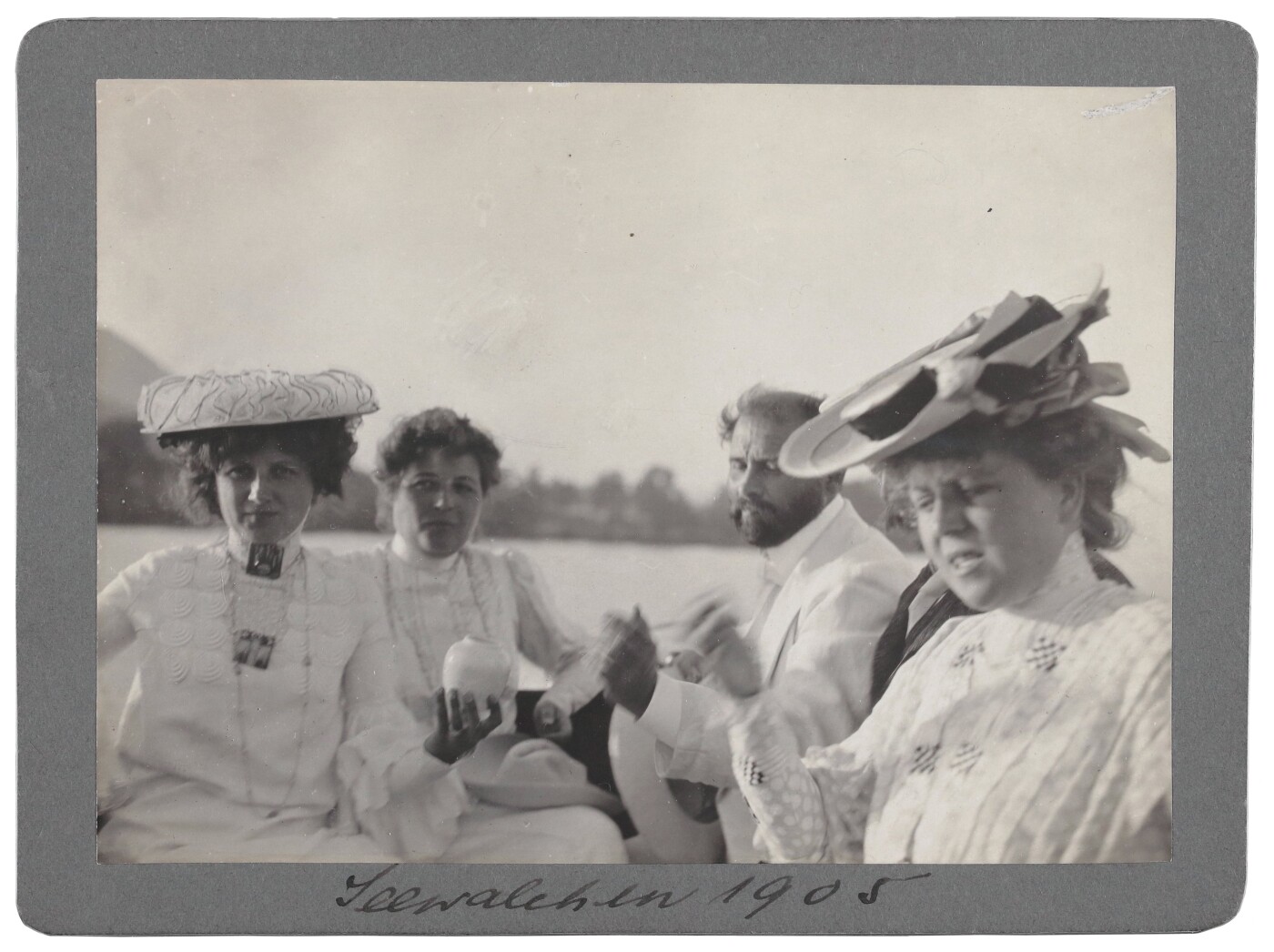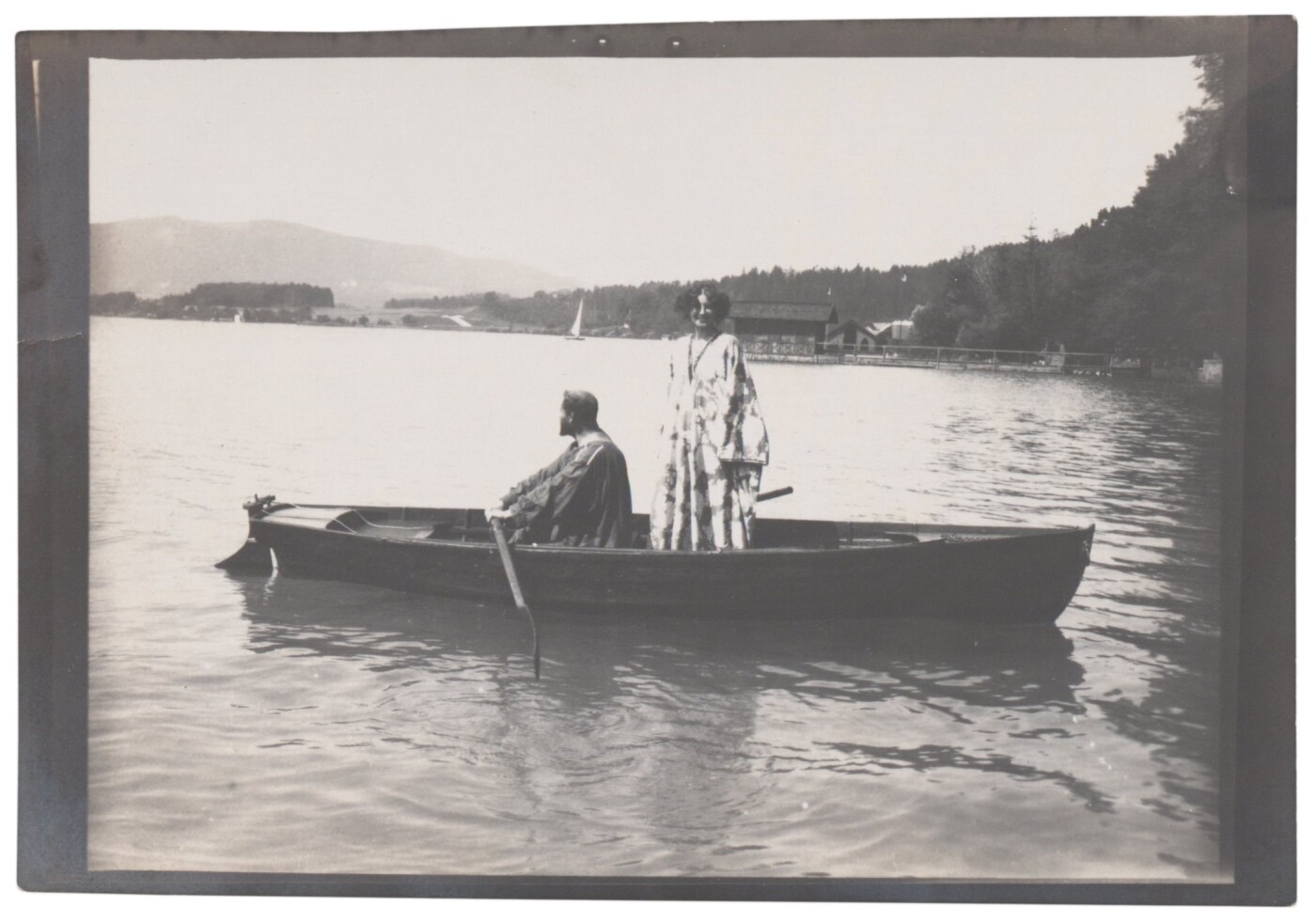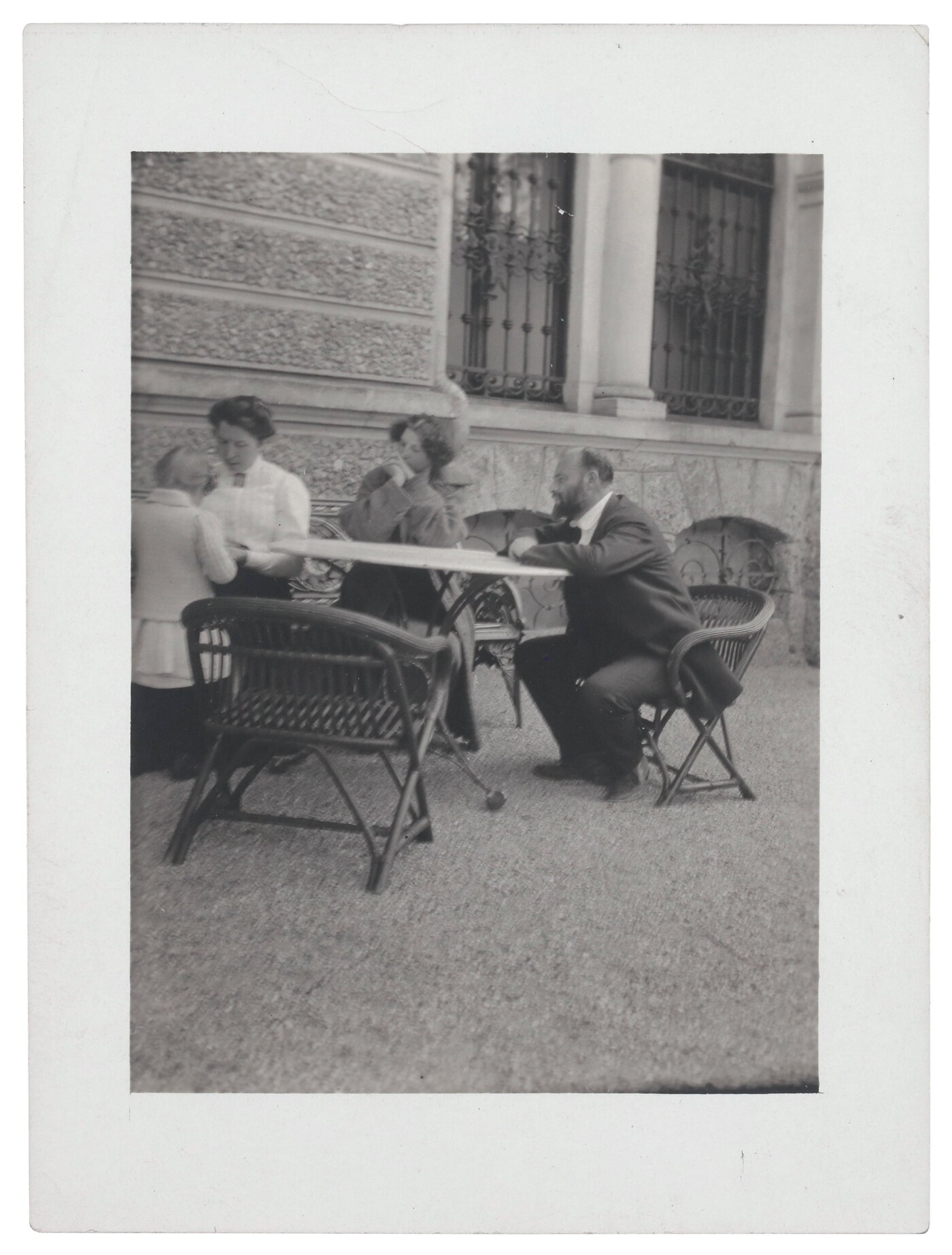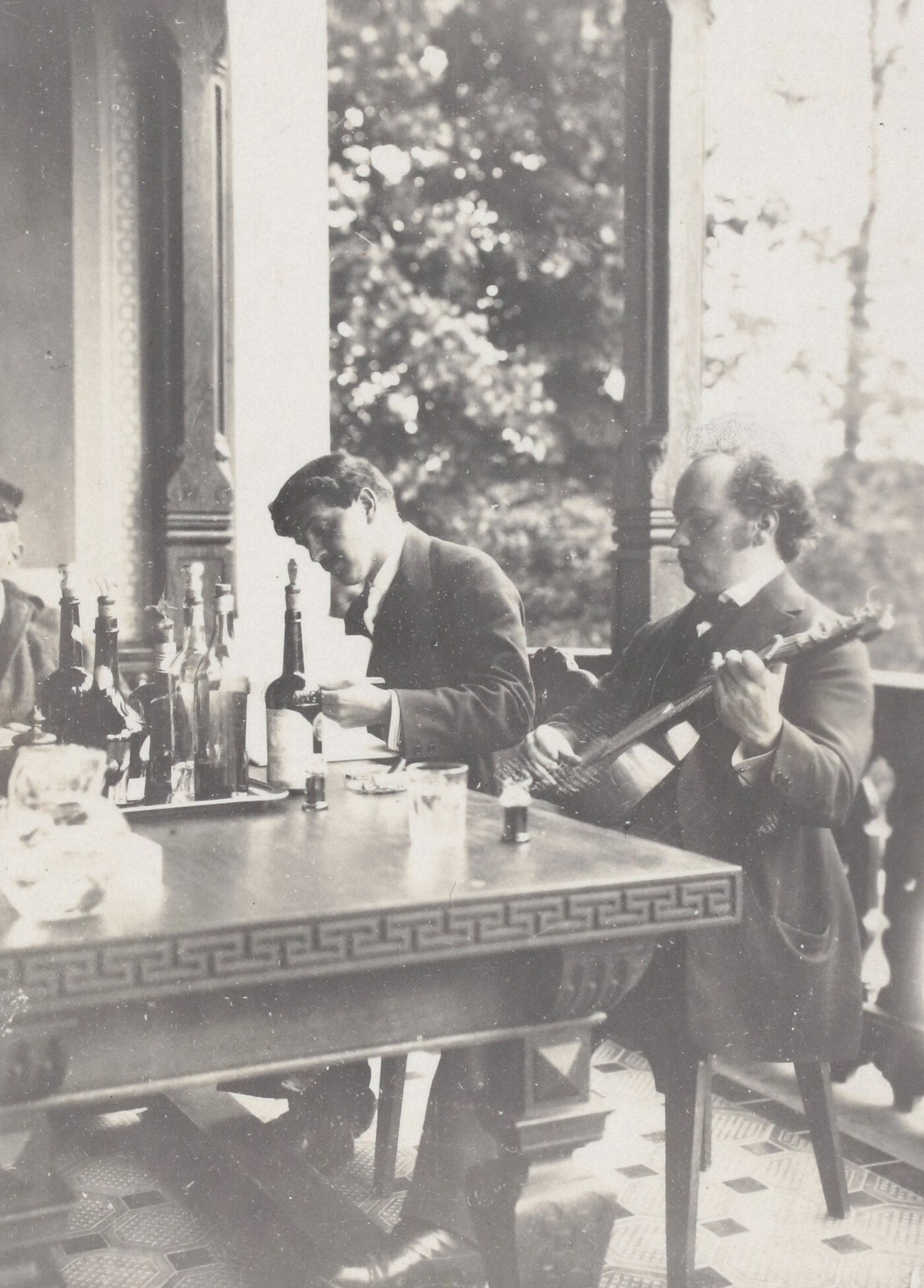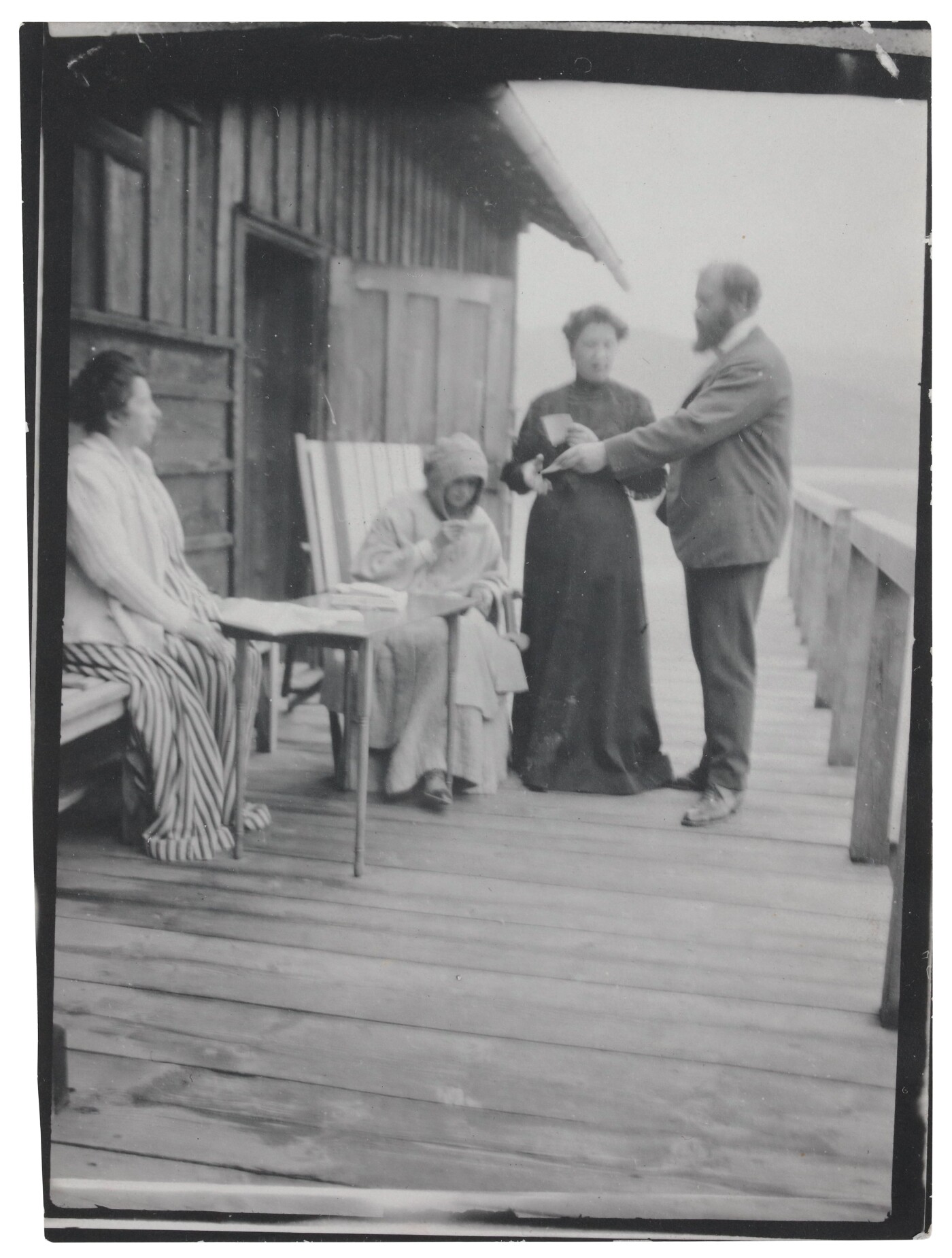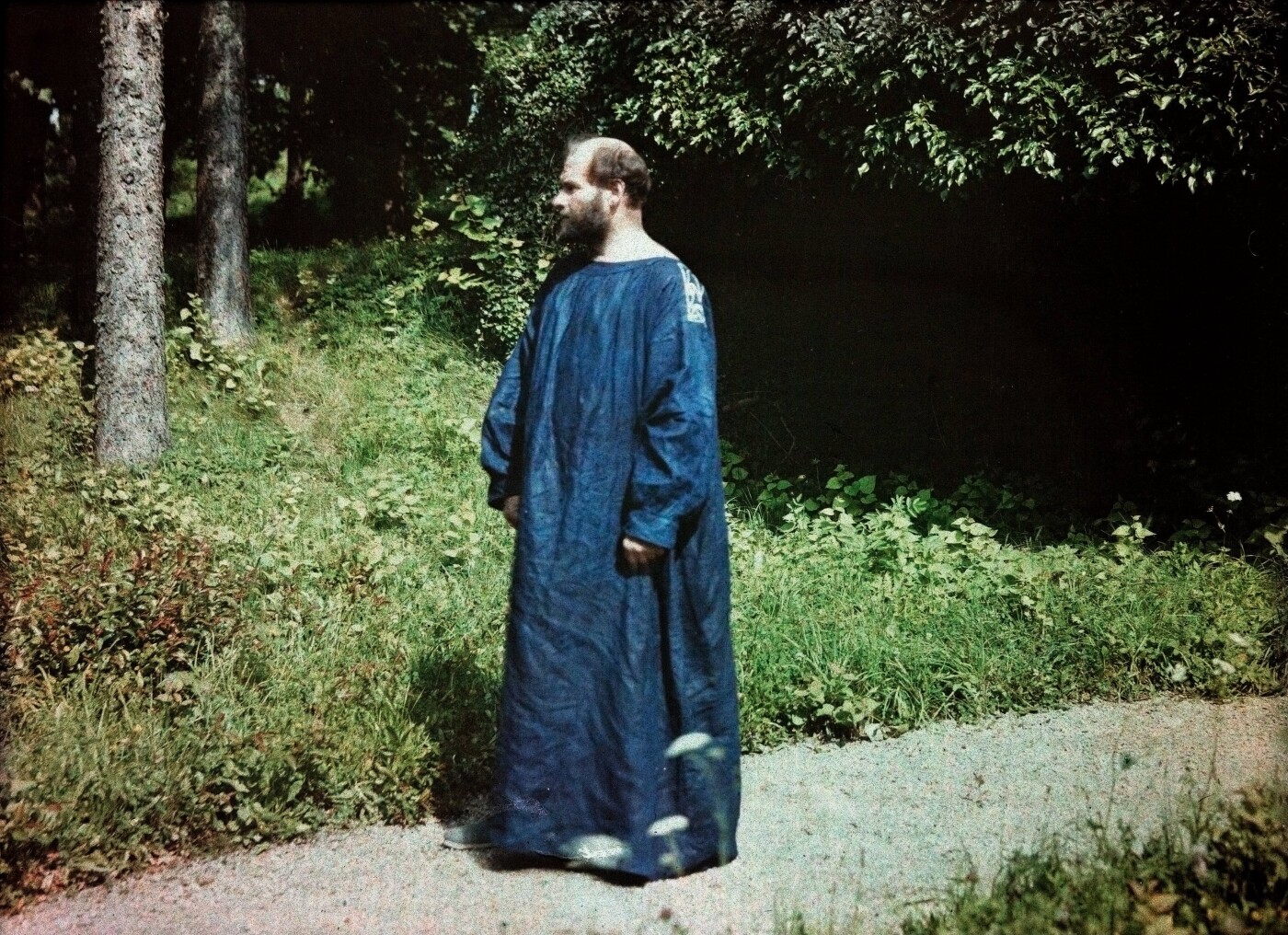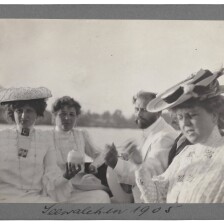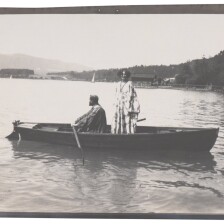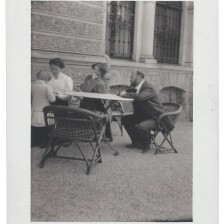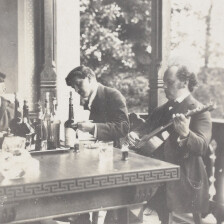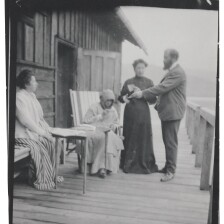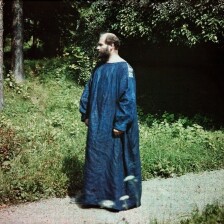The Paulick Family
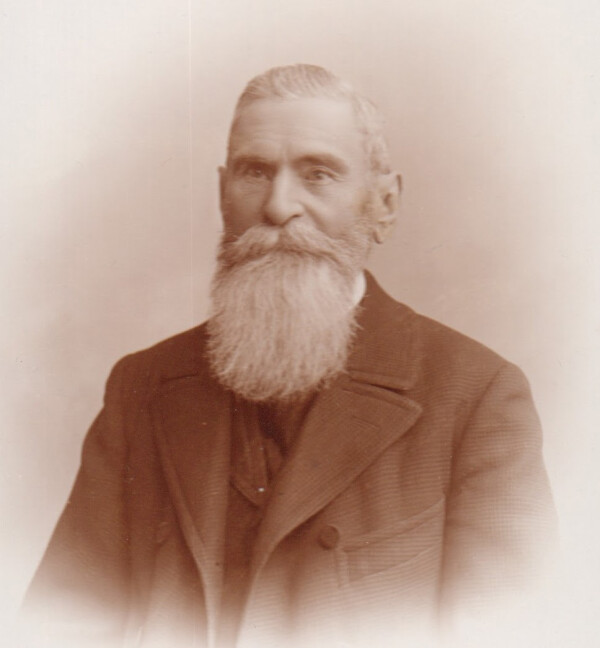
Friedrich Georg Paulick photographed by Friedrich Schiller, around 1900, Villa Paulick Collection, courtesy Klimt Foundation, Vienna
© Klimt Foundation, Vienna
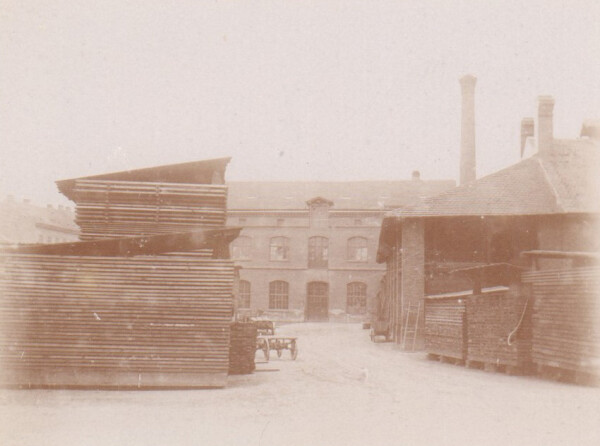
k. k. Hoftischlerei Paulick in Vienna-Erdberg, Villa Paulick Collection, courtesy Klimt Foundation, Vienna
© Klimt Foundation, Vienna
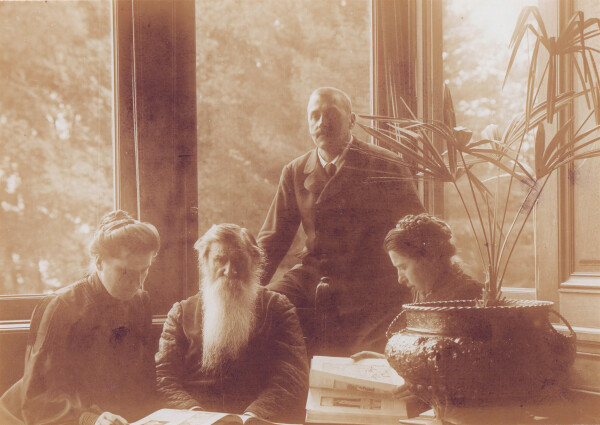
The Paulick family in the salon of Villa Paulick in Seewalchen am Attersee, Villa Paulick Collection, courtesy Klimt Foundation, Vienna
© Klimt Foundation, Vienna
The Paulick family was related by marriage to the Flöge and Klimt families, and was friendly with numerous personalities of the Vienna art scene. Friedrich Georg Paulick commissioned the building of Villa Paulick on the Attersee, which was completed in 1877. The villa was used by several generations of the family as a summer residence, and, especially around 1900, became a meeting place for Viennese society summering on the Attersee.
Friedrich Georg Paulick
Friedrich Georg Paulick was born on 1 August 1824 in Vienna, the son of the cabinetmaker Johann Christian Paulick. From 1937, he learnt the cabinetmaker’s trade from his stepfather Franz Marini, between 1840 and 1843 attended the drawing school Schmidt und Grünauer, and subsequently took over his stepfather’s workshop. In 1846, he studied architecture at the Imperial-Royal Academy of Fine Arts under August Sicardsburg, and was later employed as a draftsman in the studio run by Sicardsburg and Eduard van der Nüll. He then worked as a drawing teacher, with August Eisenmenger and Carl Hasenauer among his most famous pupils.
In 1854, Paulick took over the management of joinery Altmann, and carried out cabinetwork for many new buildings along the Vienna Ringstraße, for instance the Imperial-Royal Court Opera, the Imperial-Royal Hofburg Theater, the Kunsthistorisches Hofmuseum, the town hall, the Imperial-Royal Vienna University and the Votivkirche. Around 1868, he cut ties with the company Altmann to open up his own large-scale joinery in Vienna-Erdberg, 3rd District, in which he used woodworking machines he had imported from England. He subsequently executed numerous commissions for the imperial court (among them, the Hofburg, Palais Erzherzog Ludwig Viktor and the Hermesvilla), and in 1873, his company furnished the jury’s pavilion, the reception room and the Emperor’s pavilion for the World’s Fair in Vienna. The same year, Friedrich Georg Paulick was awarded the title of Imperial-Royal court carpenter. 1877 saw the completion of Villa Paulick in Seewalchen am Attersee, where he spent his summer sojourns with his wife Theresia (née Groner) and their four children Friedrich, Therese, Maria and Emma. At their summer residence, the family often received friends as guests, who from 1881 were asked to enter their names in the Villa Paulick’s guestbook. This guestbook, which has survived to this day, affords insights into the artistic atmosphere of the time. Gustav Klimt, too, signed the guestbook on 10 August 1900, during his first summer sojourn on the Attersee.
Paulick’s works featured in exhibitions in Austria and abroad, he won numerous prizes and distinctions, and between 1879 and 1882 was a member of Vienna’s municipal council. He further sat on the expert committee of the Imperial-Royal Technological Industrial Museum, was a member of the Lower Austrian trade association and participated in the foundation of the Imperial-Royal Österreichisches Museum, the Vienna School of Applied Arts and the Vienna Association of Applied Arts. Paulick retired from his business in 1896, and was due to be ennobled shortly before his death on 9 March 1904.
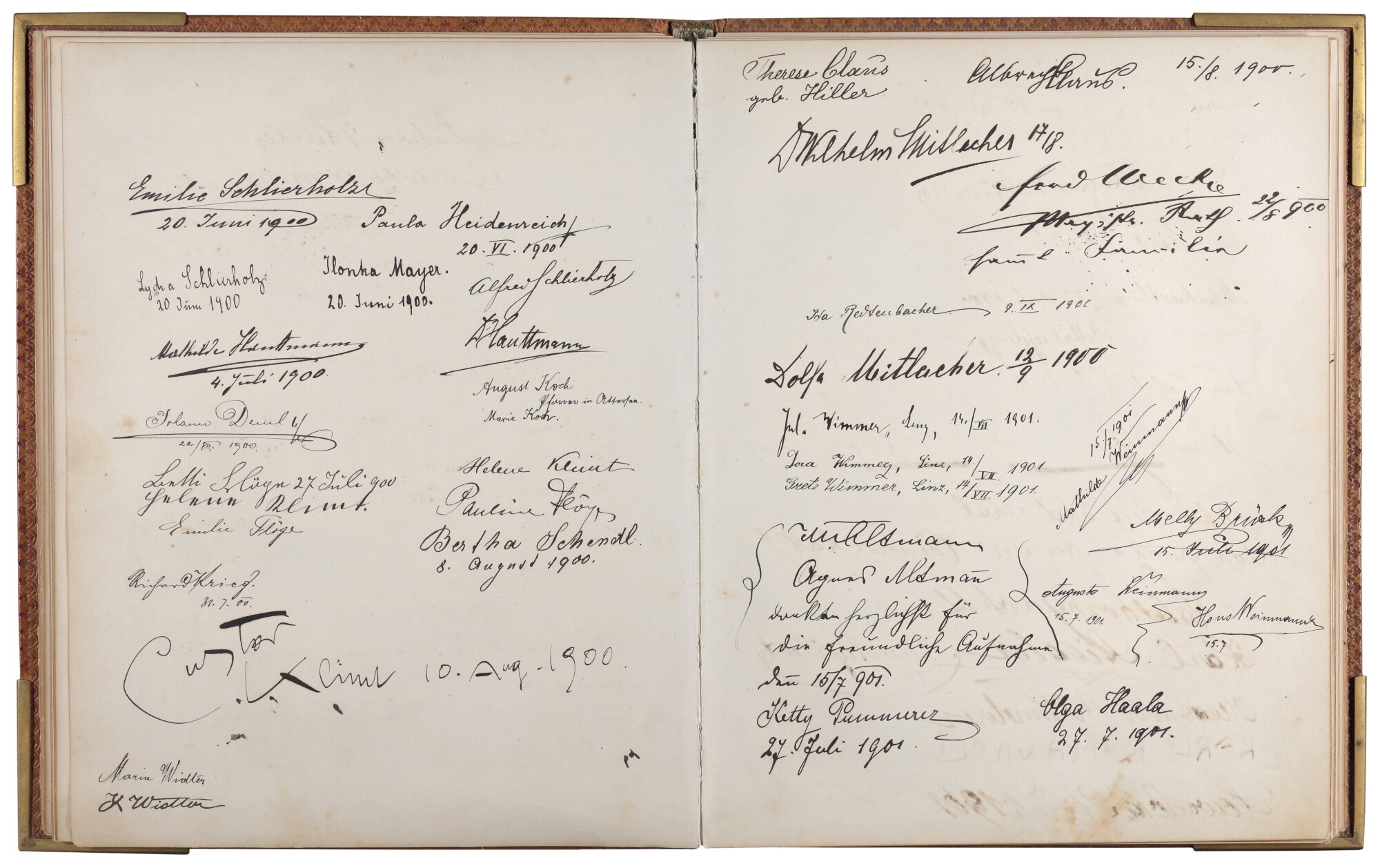
Gustav Klimt: Entry by Gustav Klimt and the Flöge family in the guest book of Villa Paulick in Seewalchen am Attersee, 08/10/1900, Sammlung Villa Paulick, courtesy Klimt-Foundation, Wien
© Klimt Foundation, Vienna

Villa Paulick in Seewalchen am Attersee, around 1910, Villa Paulick Collection, courtesy Klimt Foundation, Vienna
© Klimt Foundation, Vienna
The Villa Paulick in Seewalchen am Attersee
In 1875, the Imperial-Royal court carpenter Friedrich Georg Paulick purchased a plot of land by the lake in Seewalchen am Attersee. The villa was planned by the architects Friedrich König and Rudolf Feldscharek, who were friends with Paulick. Paulick not only participated in the planning but also had his company provide all the wooden parts for the private building project’s exterior and interior. Additionally, parts of the coffered ceiling, created by Paulick in 1873 for the Emperor’s pavilion at the World’s Fair in Vienna, were integrated into the ceiling of the villa’s parlor. The Historicist summer villa, which boasts a living area of around 430 square meters, as well as a garden and boat house, was completed in 1877, following a construction period of only one year. The villa unites asymmetrical elements, such as facades with different designs on each level, protruding and retreating parts in the shape of alcoves and verandas, a corner tower as well as an interesting roofscape. The style of the building and natural garden were inspired primarily by the villa architecture and design principles of 18th-century English landscape gardens.
The Villa Paulick was the summer residence of the bourgeois Paulick family, and soon became a popular meeting place among Viennese society: Owing to their family ties with the Flöge and Klimt families, Emilie Flöge, and from 1900 also Gustav Klimt, were frequent guests at the villa. Numerous artists and intellectuals from the family’s circle of friends came to stay on the Attersee, among them personalities like Peter Altenberg, Otto Prutscher, Carl Moll and Gustav Mahler. Popular activities on the Attersee included bathing in the lake, walks in the surrounding countryside, as well as extended boat trips with the family’s rowboat, Paul Bacher’s motorboat “Nameless” or the Böhler family’s “canoe.” A favorite spot with family members and their friends was the jetty of the villa’s boat house. The gatherings in the house, garden, by the water or during one of their many excursions are documented in numerous private photographs.
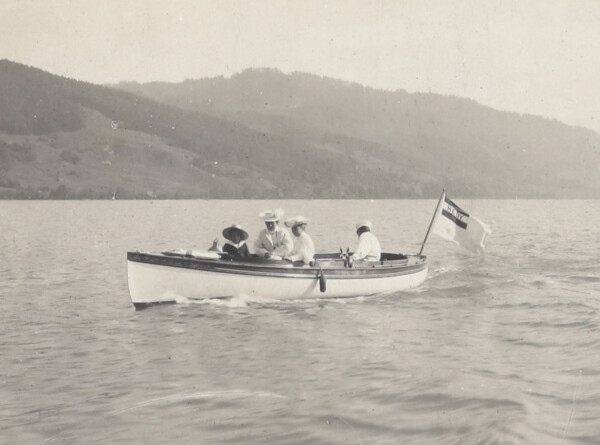
Friedrich Paulick with his family in the motorboat "Hedy" on Lake Attersee, Villa Paulick Collection, courtesy Klimt Foundation, Vienna
© Klimt Foundation, Vienna
Friedrich “Fritz” Paulick jun.
The first son of Friedrich Georg and Theresia Paulick (née Groner) was born on 11 December 1861 in Vienna. He was also named Friedrich but called “Fritz.” On 8 March 1897, he married Hedwig Brauner at the Lutheran City Church in Vienna, and the couple had two children: Hedwig Paulick, who took her husband Gustav Langer’s surname, and Fritz Paulick. Friedrich Paulick jun. was head teacher at the trade promotion service of the trade ministry and at the Imperial-Royal Technological Industrial Museum in Vienna. When his father retired, he took over the joinery. An avid yachtsman, he liked to take trips on the Attersee with his sailing yacht and his motorboat, which he called “Hedy.” In 1907, the architect Robert Oerley designed a single-level residential house for Friedrich Paulick, which was erected in the posh Viennese cottage quarter at Türkenschanzstraße 23.
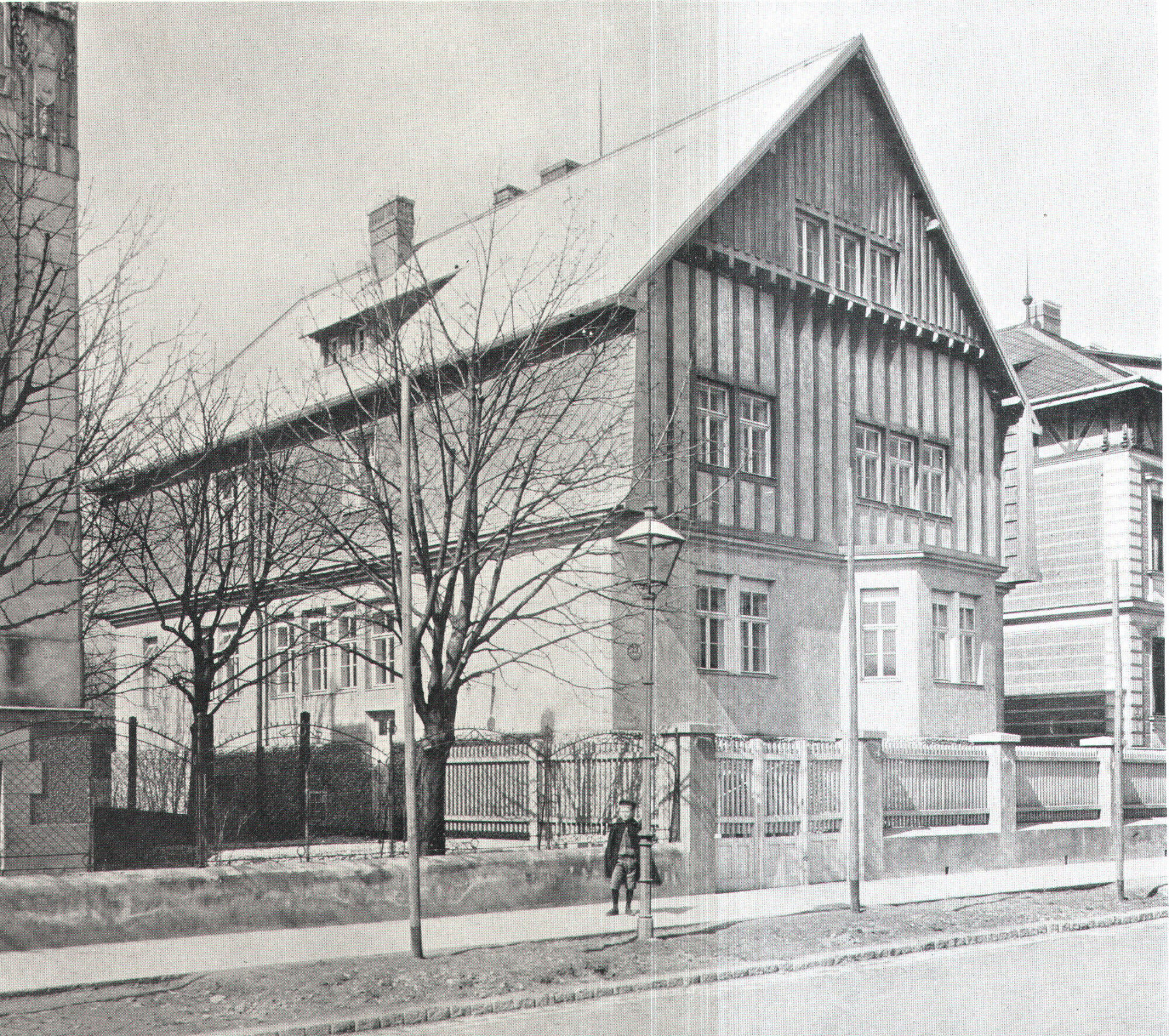
Residence for Friedrich Paulick in the Cottage Quarter, Türkenschanzstraße 23, 1190 Vienna, in: Der Architekt. Wiener Monatshefte für Bau- und Raumkunst, 16. Jg. (1910).
© ANNO | Austrian National Library
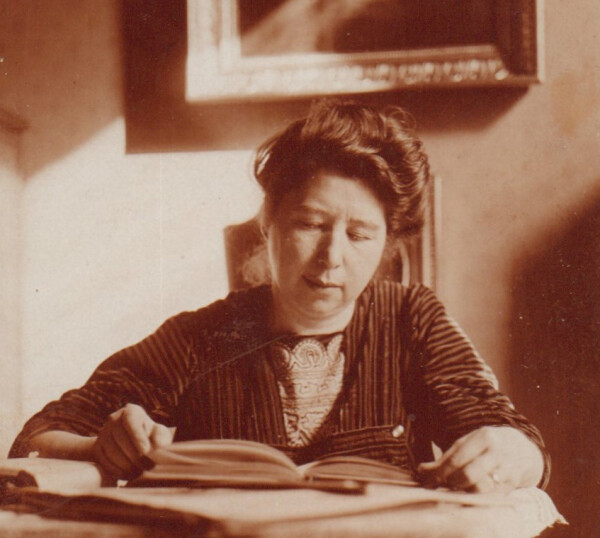
Therese Flöge (née Paulick) in the writing room of the apartment in Lindengasse, Villa Paulick Collection, courtesy Klimt Foundation, Vienna
© Klimt Foundation, Vienna
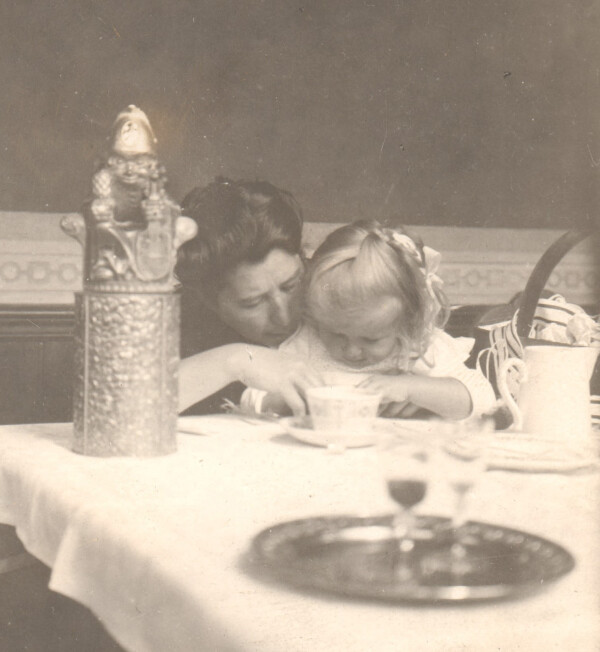
Therese and Gertrude Flöge with the household god on the veranda of Villa Paulick in Seewalchen am Attersee, around 1910, Villa Paulick Collection, courtesy Klimt Foundation, Vienna
© Klimt Foundation, Vienna
Therese “Resl” Flöge, née Paulick
Therese “Resl” Paulick, the second child of Friedrich Georg and Theresia Paulick (née Groner), was born on 5 January 1864 in Vienna. On 10 January 1906, she married Hermann Flöge, the eldest son of the Flöge family. The couple had one daughter: Gertrude “Trudl” Flöge.
Hermann’s sister Helene Flöge had married Gustav Klimt’s younger brother Ernst Klimt already in 1891. After Ernst’s untimely death, Gustav assumed guardianship of his brother’s daughter Helene “Lentschi” Flöge in 1892. Owing to the Paulick family’s ties with the Flöge and Klimt families, Gustav Klimt and Emilie Flöge were regular summer guests at Villa Paulick on the Attersee, which Therese inherited in 1904 after her father’s death. She died on 7 July 1949, and was laid to rest at Vienna’s Central Cemetery.
Gertrude “Trudl” Flöge
Gertrude Flöge, the daughter of Therese (née Paulick) and Hermann Flöge, was born on 16 December 1907, and from her early childhood spent her summers on the Attersee. Owing to the family’s ties with the Flöge and Klimt families, there are numerous extant photographs that show little Gertrude – also called “Trude” or “Trudl” – together with Emilie Flöge and Gustav Klimt. One such encounter gave rise to the photo series showing the then five-year-old with Klimt, likely at Easter 1913, on the jetty of Villa Paulick. Latest around 1915, Klimt created several portrait drawings of Gertrude Flöge. She was the last family owner of the Villa Paulick, and died on 28 July 1971.
Maria Schreiner, née Paulick
Maria Paulick, the third daughter of the Paulicks, was born on 28 September 1865. On 7 February 1887, she married the court theater actor Jakob Schreiner, with whom she had three children: Maria de Medici, Leo Schreiner and Helene Schreiner. Unlike the majority of her relatives, who were Protestants, Maria Schreiner was a Catholic. She died on 9 April 1937.
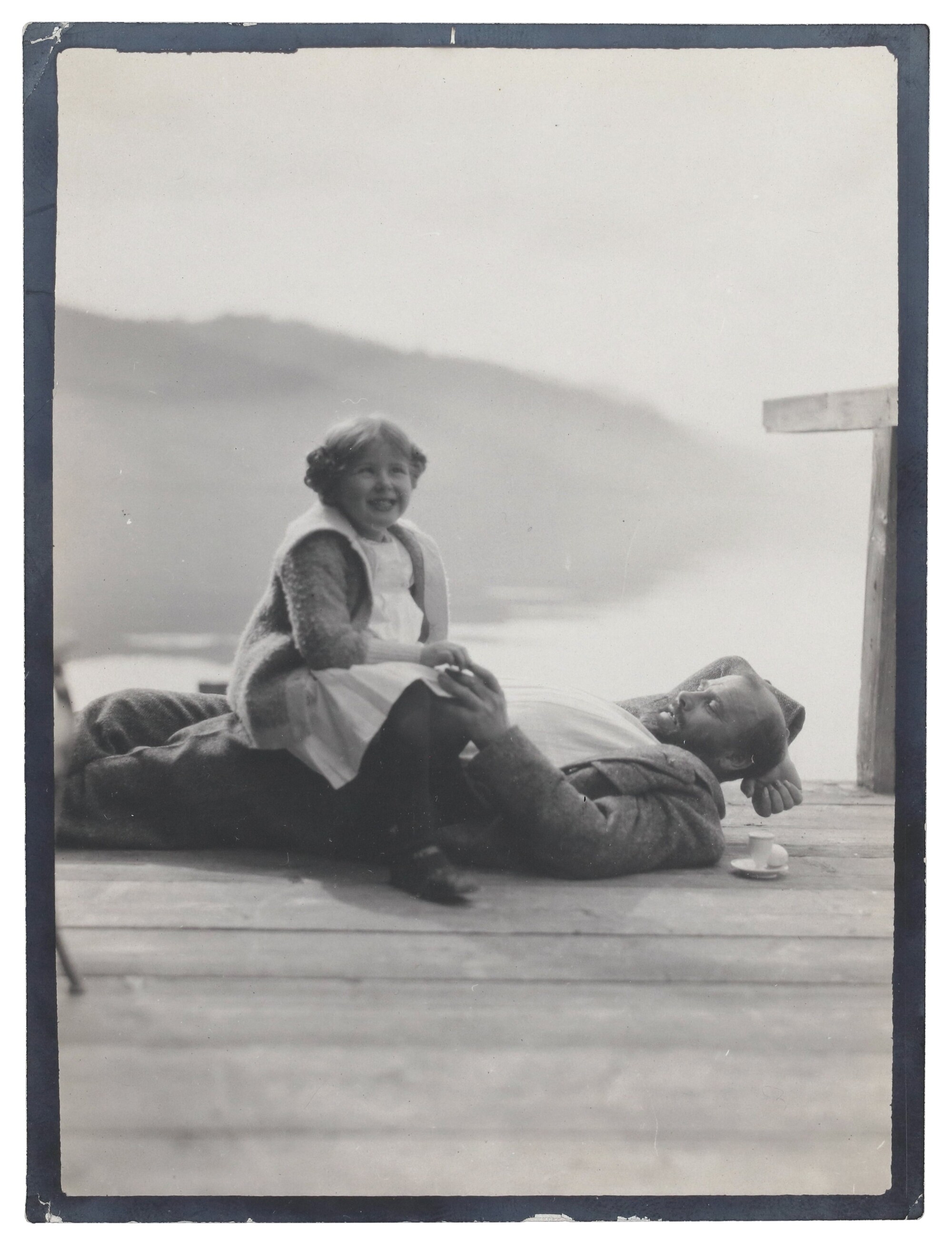
Gertrude Flöge and Gustav Klimt on the jetty at Villa Paulick, presumably March 1913, Klimt Foundation
© Klimt Foundation, Vienna
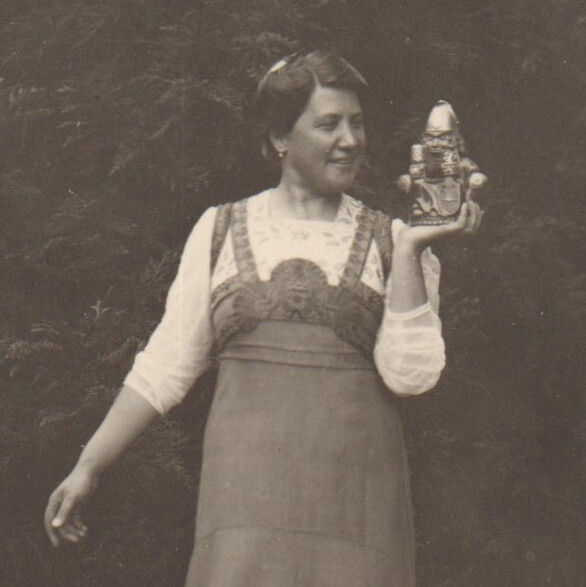
Emma Teschner with the household god of Villa Paulick, around 1911, Villa Paulick Collection, courtesy Klimt Foundation, Vienna
© Klimt Foundation, Vienna
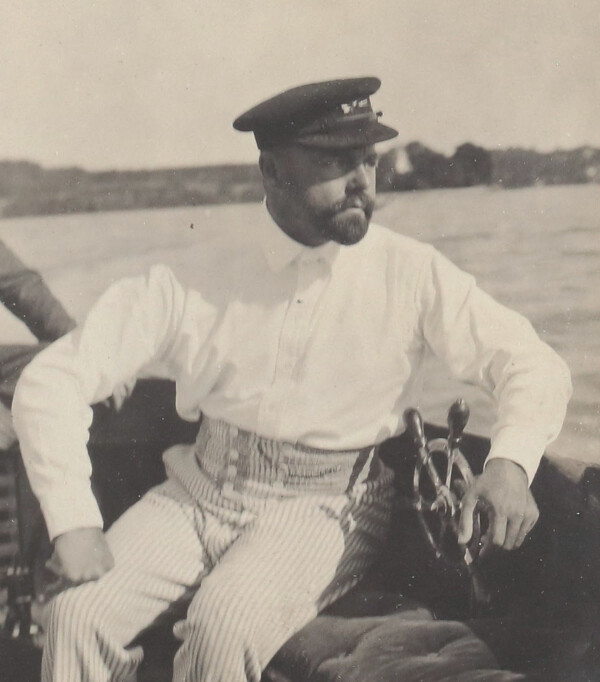
Paul Bacher in a motorboat on Lake Attersee, 1906, private collection
© Klimt Foundation, Vienna
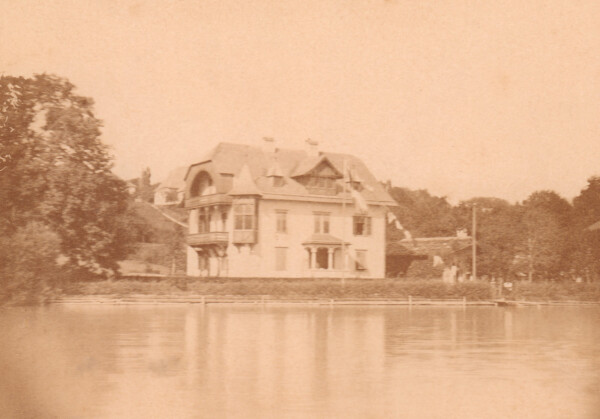
Ash tree house in Seewalchen am Attersee photographed by Nikolaus Wang, Villa Paulick Collection, courtesy Klimt Foundation, Vienna
© Klimt Foundation, Vienna
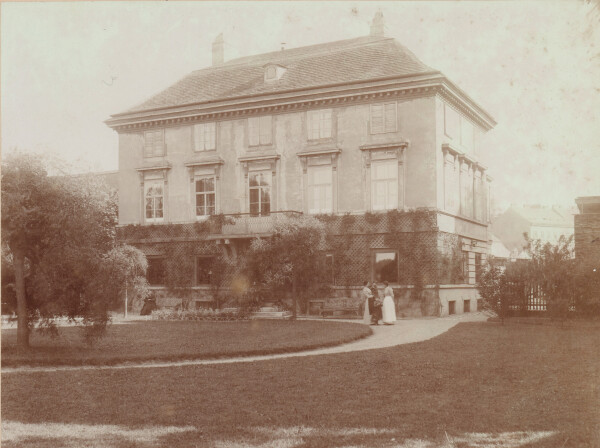
Paulick in Vienna Erdberg, Schwalbengasse 5, Villa Paulick Collection, courtesy Klimt Foundation, Vienna
© Klimt Foundation, Vienna
Emma Bacher-Teschner, née Paulick
The family’s fourth child was Emma Paulick, who was born on 27 November 1867 in Vienna. In July 1892, several members of the Bacher family visited Villa Paulick on the Attersee, and made an entry into the guestbook. Among the visitors was Paul Bacher, who worked in the family business J. & Sohn Bacher – a gold and jewelry factory – and likely met Emma Paulick latest that summer. The couple married on 4 March 1894 at the Lutheran City Church in Vienna. While they had no children, Emma was very close to her niece Gertrude “Trudl” Flöge, the daughter of Therese and Hermann Flöge. Owing to the family ties between the Paulick, Flöge and Klimt families, Villa Paulick became a popular meeting place during the summer months, especially from 1900, among family members and their numerous artist friends. Emma Bacher, who was an avid amateur photographer, “snapped” many private moments. The photographs show the Villa Paulick’s summer guests mostly during boat rides, on the jetty or in the garden.
Likely at the suggestion of Gustav Klimt, Paul Bacher bought the renowned art dealership Galerie H. O. Miethke in 1904, which, after his death in 1907, was taken over by his wife. A few days before Paul Bacher’s death, Hugo Haberfeld was hired as the gallery’s new director, alongside Carl Moll, who acted as artistic advisor.
As the proprietor of Galerie H. O. Miethke, Emma Bacher attended the opening of the exhibition “Kunstschau Wien 1908,” which she captured in photographs. Through her involvement with the gallery and her circle of friends, she was very close to numerous artists of Viennese Modernism and the Wiener Werkstätte, and thus met the Universalkünstler [universal artist] Richard Teschner. In August 1910, Teschner stayed together with Otto Prutscher on the Attersee, as is documented by an entry into the guestbook. For the Villa Paulick, Teschner designed a household deity (1910, private collection), a soapstone figure, which was published in March of that year in the periodical Deutsche Arbeit under the title “Mrs. B’s house idol.” The couple married on 18 May 1911, and Emma took his last name. In 1915, she sold Galerie H. O. Miethke to Hugo Haberfeld. Emma Bacher-Teschner died on 25 June 1953 in Vienna, and was laid to rest at Vienna’s Central Cemetery.
Residential Building “Eschenhaus” in Seewalchen am Attersee
Friedrich Georg Paulick commissioned the architect Rudolf Feldscharek to carry out another building project in Seewalchen am Attersee: Having purchased a plot adjacent to Villa Paulick, on which there used to be a farm house (no. 54, known as Botenhäusl or Reifhaus), a residential building was erected in 1887, which the family intended to rent out. The “new Villa Paulick” was advertised in 1888 in the Verzeichnis der Sommer-Aufenthaltsorte in Oberösterreich, a register of summer sojourn residences in Upper Austria, as a private home which looked like a scaled-down version of the Paulicks’ first villa. The “Eschenhaus,” situated directly on the shore, accommodated summer guests in addition to the main villa. The house blended in perfectly with the surrounding villa architecture on the Attersee, as Feldscharek once more incorporated elements such as wooden balconies, a loggia, alcoves and dormers, while the woodwork was again executed by Paulick’s joinery.
The Paulick family in Vienna
Until around 1896, the Paulick family lived at Erdbergerlände 24, Schwalbengasse 5 in the 3rd District of Vienna. The Classicist summerhouse, known as “Hagenmüllerschlössel,” which no longer exists, was situated in close proximity to the joinery. Around 1897, Friedrich Georg Paulick and his wife Therese Paulick (née Groner) moved to an apartment at Währingerstraße 33-35 in the 9th District of Vienna.
Literature and sources
- Wien Geschichte Wiki. Friedrich Georg Paulick. www.geschichtewiki.wien.gv.at/Friedrich_Georg_Paulick (04/28/2020).
- Tobias G. Natter (Hg.): Die Galerie Miethke. Eine Kunsthandlung im Zentrum der Moderne, Ausst.-Kat., Jewish Museum Vienna (Vienna), 19.11.2003–08.02.2004, Vienna 2003.
- Gästebuch der Villa Paulick. 1881–1947, , S. 36, S. 42, S. 59, S. 84.
- Eintrag von Gustav Klimt und der Familie Flöge im Gästebuch der Villa Paulick in Seewalchen am Attersee (08/10/1900). LGM 14, .
- N. N.: Villa Paulick in Seewalchen am Attersee. Von den Architekten Friedr. König und R. Feldscharek, in: Allgemeine Bauzeitung, 1880, S. 91.
- N.N., N.N.: Chronik der Marktgemeinde Seewalchen am Attersee. 1881-1900.
- Verein der Ärzte Oberösterreichs (Hg.): Verzeichnis der Sommer-Aufenthaltsorte in Oberösterreich, Linz 1888, S. 52-53.
- N. N.: Zu unseren Beilagen, in: Wiener Bauindustrie-Zeitung und Wiener Bauten-Album, 8. Jg., Nummer 20 (1891), S. 211-212.
- N. N.: Festtag eines Wiener Gewerbetreibenden, in: Die Presse, 26.07.1894, S. 3.
- N. N.: Sterbeanzeige Maria Brauner, in: Neue Freie Presse, 26.04.1898, S. 15.
- Wilhelm Exner: Das k. k. Technologische Gewerbe-Museum in Wien im ersten Vierteljahrhundert seines Bestandes. 1879 bis 1904, Vienna 1904, S. 145-147.
- N. N.: Friedrich Paulick ✝, in: Wiener Montags-Post, 14.03.1904, S. 3.
- Meldezettel, Wiener Stadt- und Landesarchiv, Akt 2.5.1.4.K11.Teschner Richard. 22.3.1879. www.wien.gv.at/actaproweb2/benutzung/archive.xhtml (04/28/2020).
- Österreichisches Biographisches Lexikon. Friedrich Georg Paulick. www.biographien.ac.at/oebl/oebl_P/Paulick_Friedrich-Georg_1824_1904.xml;internal&action=hilite.action&Parameter=paulick* (06/09/2020).
- Alice Strobl (Hg.): Gustav Klimt. Die Zeichnungen, Band III, 1912–1918, Salzburg 1984, S. 129.
- Martina Glechner: Die Villa Paulick der Architekten König & Feldscharek. Diplomarbeit, University of Vienna 1999.
- Wiener Weltausstellung 1873. Friedrich Georg Paulick. www.wiener-weltausstellung.at/biografien.html (06/04/2020).
- Trauungsbuch 1906 (Tomus TRB30), Pfarrgemeinde Wien Innere Stadt (Lutherische Stadtkirche), fol. 3.
- Rudolf Schuh: Nr. 6. "Aus meinem Leben" von Dr. Rudolf Schuh in Seewalchen am Attersee, Oberdonau - 1901 bis Anfang 1908, in: Autobiografie Dr. Rudolf Schuh, S. 1941-2287.
- Architekten- und Baumeister-Zeitung, 31.03.1907, S. 8.





